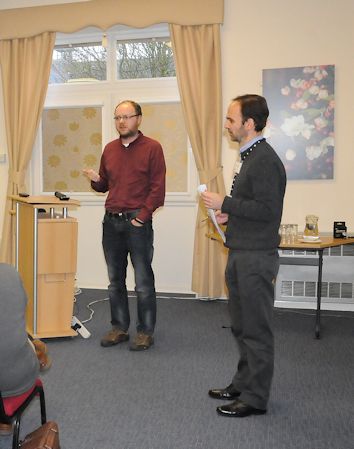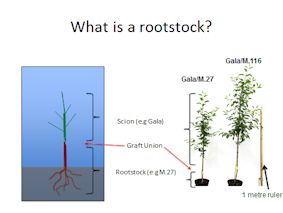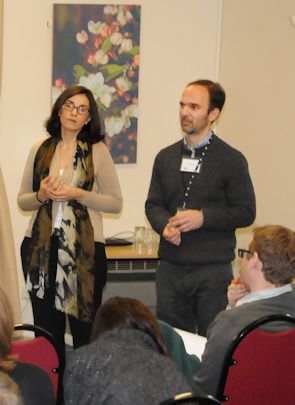

There are 7,000 + named apple varieties in recognised collections and no doubt 'tens of thousands' more 'unnamed varieties' in hedgerows across the world. However the need for apple breeding continues, with the 'holy grail' of new varieties that, not only deliver all the organoleptic attributes sought be the consumer, but the additional 'goal' of varieties with resistance to pest and disease.
Recently, The English Apple Man attended a meeting at East Malling Research (EMR) highlighting the role of sequencing in apple breeding. As apple breeders utilise DNA and the latest technology to reduce the 'variables' of breeding, this meeting demonstrated the equipment and science being embraced by our apple breeders.
An introduction from EMR
"East Malling Research, a leading organisation researching perennial and clonally propagated crops, joined llumina, in holding this event in December to showcase the benefits and opportunities that DNA technologies can bring to the UK horticulture industry.
As a research institute focused upon translation of new ideas into practical solutions for the benefit of industry, the research at East Malling naturally falls into several well-recognised categories. Diagnostics, biocontrol and how plants interact with microbes and other organisms are topics of considerable interest in this sector and a plethora of projects have been initiated over the last two years that directly harness sequencing technology to gain a deeper insight into these longstanding research areas.
Similarly, plant breeding is a discipline that has been revolutionized by the affordability of DNA sequencing technology; the parallel developments in our understanding of plant genetics and plant genomes, techniques once restricted to 'multinational' multi-million pound breeding programmes, can now be deployed in smaller programmes, for a fraction of the previous cost.
Members of the UK horticulture industry and research community were invited to see examples of work being undertaken at EMR to tackle real world problems in crop production, to see how the technologies are applied and to view the kind of information that is generated.
 Dr.Gerard Bishop - Principal Research Scientist, Molecular Biologist Chaired the Sequencing Event.
Dr.Gerard Bishop - Principal Research Scientist, Molecular Biologist Chaired the Sequencing Event.
The speakers were drawn from across EMR's three research programmes and covered advances in the understanding of key horticultural diseases, the development of new forms of diagnostic tools and the application of DNA and RNA sequencing technology in crop improvement and breeding.
DNA technologies can provide a depth of information that allows researchers to tackle complex problems in reasonable time scales that were simply not possible just a few years ago. As the speed of innovation increases and costs fall, these benefits are set to increase in the coming years".
Application of sequencing technology to the horticulture industry
In his introduction, Dr.Richard Harrison said East Malling is pleased to host this half-day event, showcasing some of the applications that 'our Illumina MiSeq Sequencing Machine has been used for over the last two years.
 Richard pointed out the changing terminology integral to a whole new area of technologies as they develop; recognising the development of a new vocabulary which may sound familiar, but is an 'incomprehensible language!
Richard pointed out the changing terminology integral to a whole new area of technologies as they develop; recognising the development of a new vocabulary which may sound familiar, but is an 'incomprehensible language!
Included in the Programme; a five page 'Glossary of Terms' has been created by the scientists working on the associated projects.
Below a 'handful of terms which may appear more frequently in presentations
DNA - Deoxyribonucleic acid: MiSeq - A desktop sized DNA sequencer: Chromosone - Discrete unit of DNA that contains genes: Genome - the entire hereditary information for an organism i.e. a complete set of genes: Linkage (Genetic) map - A diagramatic representation of the order of genes/markers in a chromosome: QTL - quantitative trait locus: Pyramid resistance genes - Combining multiple resistance genes to reduce the pressure for the pathogens to overcome the resistance: Virulence - The degree of pathogenicity, the ability of the organism to invade the tissues of the host:
![]() The English Apple Man (along with several other industry representatives) was in awe of the scientific community at the Sequencing Technology Event, some of the content was beyond our understanding; 'that is not a criticism' but a reflection of the advancement in science and technology which is now being 'harnessed' by scientists at East Malling Research for the benefit of our growers and consumers.
The English Apple Man (along with several other industry representatives) was in awe of the scientific community at the Sequencing Technology Event, some of the content was beyond our understanding; 'that is not a criticism' but a reflection of the advancement in science and technology which is now being 'harnessed' by scientists at East Malling Research for the benefit of our growers and consumers.
As the morning progressed, the link between the science of sequencing DNA and the practical benefits became much clearer;
The overview (below) of the respective presentations is an 'extract' from the programme notes and hopefully will give English Apple Man readers a flavour of the research benefits made possible by Illumina Sequencing machines.
Illumina Technologies
The first speaker; Laurie Scott - Illumina, said 'Next Generation Sequencing is becoming faster and cheaper making it more accessible and open to a wider range of applications.
As new versions of sequencing machines become available, the scope for interrogating DNA is on an exponential curve. The latest machines cost 10,000 million US dollars.
 Dr.Edward Dobbs, EMR - Virus epidemiology and the genome(s) of MVX
Dr.Edward Dobbs, EMR - Virus epidemiology and the genome(s) of MVX
The Mushroom Virus X (MVX) disease is the cause of serious commercial damage to the cultivated 'white button mushroom' causing brown discolouration of the mushroom and delay in cropping and malformation of the fruit bodies. Using the MiSeq benchtop sequencer it has been possible to use the viral RNA sequences to detect and quantify the viruses. It is now possible to test compost for viruses before it is used by the mushroom growers.
Prof. Xiangming Xu, EMR - Ribosomal profiling of diseased soils
 A phenomenom of yield decline (stunted plant growth) in strawberry was recently observed in non-fumigated soils; the yield decline was not associated with the soil pathogen 'Verticillium dahliae , the main target of fumigation. Amplicon metagenomics microbial organisms that may have caused the yield decline.was used to profile soil microbotia in order to identify microbial organisms that may have caused the yield decline. More than 2,000 fungal or bacterial operational taxonomy units (OTU's) were found in these samples. The results suggested that yield decline resulted likely from one or more of the following four factors: 1) low abundance of Bacillus and Psuedomonas populations, which are known to suppress pathogen development and/or promoting plant growth. 2) lack of namatophagous fungus; 3) a high level of two candidate fungal pathogens and 4) wet soil conditions as indicated by abundance of several wet-loving microbes.
A phenomenom of yield decline (stunted plant growth) in strawberry was recently observed in non-fumigated soils; the yield decline was not associated with the soil pathogen 'Verticillium dahliae , the main target of fumigation. Amplicon metagenomics microbial organisms that may have caused the yield decline.was used to profile soil microbotia in order to identify microbial organisms that may have caused the yield decline. More than 2,000 fungal or bacterial operational taxonomy units (OTU's) were found in these samples. The results suggested that yield decline resulted likely from one or more of the following four factors: 1) low abundance of Bacillus and Psuedomonas populations, which are known to suppress pathogen development and/or promoting plant growth. 2) lack of namatophagous fungus; 3) a high level of two candidate fungal pathogens and 4) wet soil conditions as indicated by abundance of several wet-loving microbes.
 Dr.Louisa Robinson Boyer, EMR - Adaption of AMF to new hosts
Dr.Louisa Robinson Boyer, EMR - Adaption of AMF to new hosts
Arbuscular mycorrhiza fungi (AMF) are found in terrestrial ecosystems where they are major components of the soil microbial biomass. They form a mutualistic symbiosis with more than 80% of vascular plant families. AMF form arbuscules within the roots of plants that allow the transfer of nutrients between the fungus and plant roots.
 Dr.Andrew Armitage, EMR - Developing diagnostics for invasive pathogens
Dr.Andrew Armitage, EMR - Developing diagnostics for invasive pathogens
Increased movement of plant material between countries risks establishment of no-native diseases in the UK. Screening for the presence of quarantine organisms need to be rapid and unambiguous. Genome sequencing offers the opportunity to new regions of DNA that are highly variable within species complexes, allowing resolution of quarantine and non-quarantine species.
Dr.Richard Harrison, EMR - The genome of Fusarium oxysporum fsp cerae sequencing populations of pathogens
 Fusarium oxysporum f. sp. cepae is the primary cause of onion basal rot and is a primary pathogen of onion in the UK. In order to understand more about this pathogen, a reference genome of a highly virulent isolate was generated. PCR tests revealed the presence of conserved effector genes, known from other species to be housed on a conditionally dispensible chromosome and essential for virulence. Genome sequancing of further isolates using the Illumina MiSeq system has revealed the level of variability in UK populations of the pathogen and the level of conservation of effector genes. The application of these technologies will inform future diagnostic tests and resistance breeding efforts.
Fusarium oxysporum f. sp. cepae is the primary cause of onion basal rot and is a primary pathogen of onion in the UK. In order to understand more about this pathogen, a reference genome of a highly virulent isolate was generated. PCR tests revealed the presence of conserved effector genes, known from other species to be housed on a conditionally dispensible chromosome and essential for virulence. Genome sequancing of further isolates using the Illumina MiSeq system has revealed the level of variability in UK populations of the pathogen and the level of conservation of effector genes. The application of these technologies will inform future diagnostic tests and resistance breeding efforts.
 Laima Antanaviciute, EMR - The development of an apple rootstock linkage map using the Malus Infinium whole generation genotyping array
Laima Antanaviciute, EMR - The development of an apple rootstock linkage map using the Malus Infinium whole generation genotyping array
In her presentation Laima explained how using the Illumina Infinium !! genotyping platform, the screening of the RosBREED whole genome genotyping array in the M432 (M.27 x M.116) apple rootstock mapping population tested the array transferability in the rootstock progeny, allowing the construction of a high density SNP-based linkage map.
In addition the aim was to increase the percentage of the Malus genome sequence that could be directly related to regions of the M432 genome, which could be used for candidate gene identification and molecular marker development and QTL mapping.
 Dr.Nicola Harrison, EMR - Uncovering dwarfing capability in apple rootstocks using whole-genome sequencing
Dr.Nicola Harrison, EMR - Uncovering dwarfing capability in apple rootstocks using whole-genome sequencing
 The technique of grafting has been practiced for hundreds of years in order to maintain, crop and propagate fruit varieties. All tree fruit crops grown commercially are grafted onto rootstocks selected for specific traits; growth control, and early bearing. An important trait is the ability for the rootstock to control the vigour of the scion (variety grafted onto rootstock) this known as 'dwarfing' a process that we still do not understand the genes and metabolic pathways involved in this trait.
The technique of grafting has been practiced for hundreds of years in order to maintain, crop and propagate fruit varieties. All tree fruit crops grown commercially are grafted onto rootstocks selected for specific traits; growth control, and early bearing. An important trait is the ability for the rootstock to control the vigour of the scion (variety grafted onto rootstock) this known as 'dwarfing' a process that we still do not understand the genes and metabolic pathways involved in this trait.
Nicola said a high percentage of bark on the roots of apple rootstocks has peviously been associayed with dwarfing rootstocks (Beakbane 1947). 'Put simply a dwarfing rootstock has a higher bark ratio' and by using a an apple rootstock seedling population together with its associated genetic map it has been possible to identify two regions in the genome associated with root bark percentage, termed: 'Root bark 1 (Rb 1) and Root bank 2 (Rb 2). Both have been found in the same genomic regions previously associated with the 'dwarfing trait' this has allowed the root bark percentage to be used as a 'proxy' for dwarfing ability in rootstocks.
 Dr.Emma Skipper, EMR - Cherry genotyping and QTL mapping for fruit quality traits
Dr.Emma Skipper, EMR - Cherry genotyping and QTL mapping for fruit quality traits
The breeding of new sweet cherry varieties with enhanced fruit quality traits is a priority for breeding programs worldwide. To date breeding strategies for new varieties have relied on conventional breeding, which uses the 'observable' characteristics (phenotype) of existing varieties for the production of 'hybrids' through crossing. However, this approach is often time consuming and expensive.
The use of recently developed 'marker assisted breeding' (MAB) which utilises molecular (DNA) markers, which reveal differences in the genetic makeup of a plant (genotype) that are tightly linked with traits of interest to the breeder, as a substitute or to assist phenotype screening.
The use of the new technologies will mean better varieties, with greatly reduced costs in the breeding process and a reduction in breeding timescale.
 Michelle Hulin. EMR - Host jumping in cherry pathogens-using sequencing to discover host range evolution
Michelle Hulin. EMR - Host jumping in cherry pathogens-using sequencing to discover host range evolution
The globally important phytopathogen, Pseudomonas syringae, encompasses pathovers that infect over 180 plant species. Individual pathovers are usually only able to 'one' of a few 'hosts' However despite this high degree of specialisation, host jumps have occurred frequently within P. syringae. It is believed genetic alteration may enable the evolution of host range expansion.
 Dr.Charlotte Nellist, EMR - Disease resistance in strawberry
Dr.Charlotte Nellist, EMR - Disease resistance in strawberry
The UK strawberry industry faces major challenges, with growers encountering increasingly unpredictable and variable weather conditions. These conditions coupled with the withdrawal of many fungicides and soil fumigants are resulting in increasing crop losses due to soil-borne diseases such as strawberry crown rot (Phytophthora cactorum) and strawberry 'red core' (Phytophthora
fragariae)
The aim of he project id to identify and pyramid resistance genes against these two economically important pathogens leading to disease resistant strawberry cultivars.
 Carla Simoes, Illumina - Roundup of Illumina technology applications
Carla Simoes, Illumina - Roundup of Illumina technology applications
Carla summarised the astonishing speed of sequencing development;
Comment from The English Apple Man:
This was a fascinating morning spent at EMR in the company of a predominately scientific audience, with a 'smattering' of agronomists, nurserymen and The EAM.
Initially the complex nature of DNA Sequencing 'flew over my head' (not just my head) but as the morning developed, the understanding between science and the practicality of growing fruit grew ever closer. The work being carried out at EMR is exciting; the potential for new varieties of apples, cherries and other fruit is gaining speed and the possibility of fruit with pest & disease resistance is not just a dream!
That's all for now...............
Take care
The English Apple Man